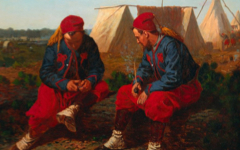Homer’s Fox Hunt (1893)

Homer, The Fox Hunt (1893) Oil on canvas. Pennsylvania Academy of the Fine Arts, Philadelphia
Click image to enlarge.
One of the little-known secrets of art history is that artists identify with animals, often sensing that they share some aspect of the animal's nature. In this example, first noted by John Wilmerding, Homer makes his identification with the fox clear by altering his signature in the lower left-hand corner to resemble the shape of the fox.
Click next thumbnail to continue

Top: Detail of Homer's Fox Hunt
Bottom: Detail of Homer's signature in The Fox Hunt
Click image to enlarge.
His signature, "Homer" (bottom), even sinks into the snow as though it had weight like an animal and is placed on the same diagonal as the fox. The left upright of the H also extends to the left like the fox's paw.1 Now that we know of Homer's self-representation, the fox's pose is significant because it would have echoed the artist's own pose. Like Homer, the animal faces the canvas with an arm (or leg) extended to paint. The fur of the fox's paw recalls the soft hair of a paintbrush while the snow-covered ground substitutes for the partly-blank canvas during its creation.
Keep an eye out for animals in a similar pose elsewhere. There are far more of them in art than have ever been recognized.
More Works by Homer
Notes:
1. John Wilmerding, Signs of the Artist: Signatures and Self-Expression in American Paintings (Yale University Press) 2003
Original Publication Date on EPPH: 17 Feb 2011. | Updated: 0. © Simon Abrahams. Articles on this site are the copyright of Simon Abrahams. To use copyrighted material in print or other media for purposes beyond 'fair use', you must obtain permission from the copyright owner. Websites may link to this page without permission (please do) but may not reproduce the material on their own site without crediting Simon Abrahams and EPPH.


